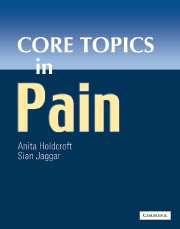Book contents
- Frontmatter
- Contents
- Contributors
- Preface
- Acknowledgements
- Foreword
- General abbreviations
- Basic science abbreviations
- PART 1 BASIC SCIENCE
- PART 2 PAIN ASSESSMENT
- Section 2a Pain measurement
- Section 2b Diagnostic strategies
- PART 3 PAIN IN THE CLINICAL SETTING
- Section 3a Clinical presentations
- Section 3b Pain syndromes
- PART 4 THE ROLE OF EVIDENCE IN PAIN MANAGEMENT
- PART 5 TREATMENT OF PAIN
- Section 5a General Principles
- 32 Overview of treatment of chronic pain
- 33 Multidisciplinary pain management
- Section 5b Physical treatments
- Section 5c Pharmacology
- Section 5d Psychosocial
- PART 6 SUMMARIES
- Glossary
- Index
33 - Multidisciplinary pain management
from Section 5a - General Principles
Published online by Cambridge University Press: 10 December 2009
- Frontmatter
- Contents
- Contributors
- Preface
- Acknowledgements
- Foreword
- General abbreviations
- Basic science abbreviations
- PART 1 BASIC SCIENCE
- PART 2 PAIN ASSESSMENT
- Section 2a Pain measurement
- Section 2b Diagnostic strategies
- PART 3 PAIN IN THE CLINICAL SETTING
- Section 3a Clinical presentations
- Section 3b Pain syndromes
- PART 4 THE ROLE OF EVIDENCE IN PAIN MANAGEMENT
- PART 5 TREATMENT OF PAIN
- Section 5a General Principles
- 32 Overview of treatment of chronic pain
- 33 Multidisciplinary pain management
- Section 5b Physical treatments
- Section 5c Pharmacology
- Section 5d Psychosocial
- PART 6 SUMMARIES
- Glossary
- Index
Summary
Pain has been viewed in the past as many things, ranging from a philosophical concept to a religious manifestation of wrong doing. It is now recognized as a complex phenomenon with biological, psychological, social and spiritual issues needing to be considered. Pain chronicity potentially impacts greatly on an individual's well being, requiring management, rather than treatment aimed at a cure. Medical management may in many cases reinforce the characteristics exhibited by patients with chronic pain. It may raise their hopes and expectations of a cure and total pain relief, which is not realistic — chronic pain is unlikely to go away. Therefore, patients should be encouraged to get on and live with their condition, by taking control and managing their illness and health, rather than being controlled by it.
Self-management of health by patients with any chronic illness is well established. The aim is to provide the person with the knowledge and skills to enable them to become the active participant in their day-to-day management. In doing so the emphasis and responsibility of a patient's health shifts from the doctor in the health care environment, to the patient in their home environment. Self-management of health, implemented through a multidisciplinary team (MDT) offers a comprehensive approach to this.
- Type
- Chapter
- Information
- Core Topics in Pain , pp. 223 - 226Publisher: Cambridge University PressPrint publication year: 2005
- 2
- Cited by



